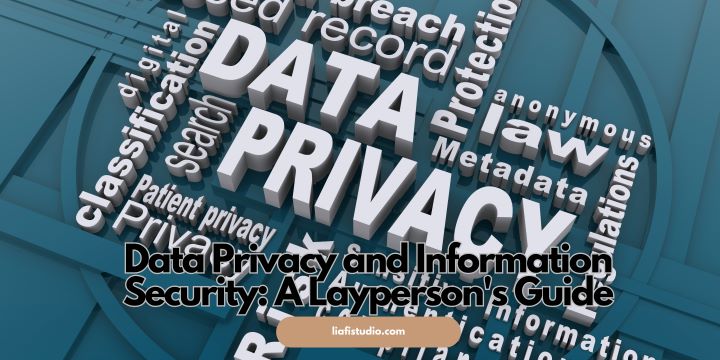Key Takeaways
- An essential understanding of both data privacy and information security.
- Recognition and avoidance of prevalent cyber threats.
- Implementing effective protocols to enhance data protection.
- The ability to identify and respond to data breaches.
- Comprehending the extensive impact of data infringements.
- Keeping updated with resources and training for evolving security measures.
Table of Contents
- Data Privacy and Information Security: What Does It All Mean?
- The Everyday User’s Vulnerability: Common Threats to Be Aware Of
- Protection Protocols: Simple Steps to Secure Your Data
- Recognizing the Signs: How to Identify a Data Breach
- Aftermath of a Data Breach: Understanding the Impact
- Educational Resources: Staying Informed and Equipped
Data Privacy and Information Security: What Does It All Mean?
Imagine a world where every piece of your personal information is just floating around, accessible to anyone who bothers to seek it out. From phone numbers to medical records, everything would be exposed. This is the scenario that data privacy and information security move to prevent. Information security involves technical means to protect our data integrity, confidentiality, and availability. In contrast, data privacy concerns handling and consent mechanisms surrounding data collection, processing, and dissemination. Data privacy training can translate these concepts into actionable knowledge for those who need to be entrenched in tech speak.Data privacy regards an individual’s right to control how their personal information is collected and used. It touches upon the legal expectations and ethical considerations companies must abide by when dealing with personal information. On the other hand, information security is the muscle that protects this data from threats, whether internal or external, digital or physical. It’s about ensuring only the right people can access the correct information at the right time.
The Everyday User’s Vulnerability: Common Threats to Be Aware Of
Phishing scams, fileless malware, ransomware, and social engineering attacks are diverse threats lurking in the seemingly benign corners of the digital world, waiting to strike when users let their guard down. Phishing attacks cleverly masquerade as legitimate requests, often prompting users to click on a link or download an attachment, which instead grants attackers access to sensitive information. These attacks have grown in sophistication, making constant vigilance and knowledge a non-negotiable part of any internet user’s daily routine. Even for the tech-savvy, keeping pace with the vast array of cyber threats can be daunting. It is beneficial to follow technological news from trusted sources such as the New York Times Technology section, as it regularly reports on new threats and vulnerabilities. Incorporating an awareness of these threats into daily digital habits can significantly boost a user’s defense against cyber-attacks.
Protection Protocols: Simple Steps to Secure Your Data
The steps necessary to protect personal and professional data can often be surprisingly straightforward. Embracing robust passwords that combine letters, numbers, and symbols and changing them regularly is a first line of defense. Equally crucial is the implementation of comprehensive security software. This digital sentinel actively wards off many cyber threats and should be a staple across devices. Another layer of security is multi-factor authentication, which requires two or more verification factors to access a resource, like a data file or an online account. This typically combines something you know (a password), something you have (a trusted device that is not easily duplicated, like a phone), and something you are (biometrics, like fingerprints). It won’t eliminate the risk of data breaches, but it can make significant strides in compounding the difficulty of unauthorized access.
Recognizing the Signs: How to Identify a Data Breach
Individuals and organizations must identify a data breach swiftly. Early detection can prevent further compromise and allow for a timely response. Unexpected financial transactions, unusual activity in online accounts, or the discovery of malware are all signs that may point to a breach. Vigilance can be the difference between a contained incident and a full-blown crisis. Expert resources like Krebs on Security provide comprehensive, up-to-date reports on recent breaches and cybersecurity trends for those who wish to take a proactive approach—subscribing to such resources arms users with the knowledge to identify telltale signs of data breaches and understand the appropriate responses.
Aftermath of a Data Breach: Understanding the Impact
After a data breach occurs, understanding its impact is critical. Individuals may face financial loss from stolen funds or fraud, while companies can incur hefty fines for failing to protect customer data adequately. There are also less tangible but equally significant consequences, like the erosion of customer trust and potential damage to brand reputation. On a broader scale, data breaches can shake the foundation of entire industries, altering how businesses and customers interact. In extreme cases, they can even influence the regulatory landscape, leading to stricter laws and guidelines governing how data should be secured – and how breaches should be handled.
Educational Resources: Staying Informed and Equipped
Understanding the nuanced world of data privacy and security isn’t a one-time effort—it’s a continuous process. As the landscape of digital threats evolves, so do our strategies for defending against them. This includes everything from staying abreast of new legislation affecting data privacy to adopting the latest recommended best practices in information security. Subscribing to dependable news resources, following thought leaders in cybersecurity, and participating in educational programs like data privacy training are all advantageous investments in this digital age. The dissemination of this vital knowledge informs and strengthens the efforts against data intrusion and misuse, effectively keeping our personal and professional information just that—personal and professional.




